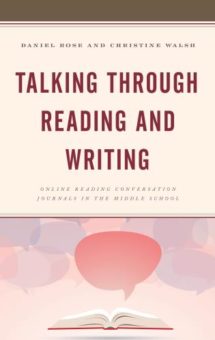Taking Middle Schoolers’ Reading Journals Online
Talking Through Reading and Writing: Online Reading Conversation Journals in the Middle School
By Daniel Rose and Christine Walsh
(Rowman & Littlefield, 2021 – Learn more)

Hi, Mr. Rose and Ms. Walsh,
I just finished reading your book. In the past, I’ve tried using reading logs and reading letters as scaffolds to help students write a thoughtful three-paragraph letter. I loved the reading letters strategy, but couldn’t find the time to sustain them. Your book inspired me to try again.
I began with a letter to my students:

And here’s the other thing. You’ve been begging me (some of you) for more reading time. Mr. Rose and Ms. Walsh reminded me that “Readers get better at reading by reading, just as students write better by writing” (p. 17). They go on to say “Teachers should never feel guilty about providing sustained, silent, free-choice reading time” (p. 17).
This book convinced me to give it a try. So let’s get started. Today you’ll have some time to read. And then you’ll have some time to write about your book. What are you reading right now? Why did you choose that book? How is your reading life going right now? I look forward to starting the conversation with you again.
They read. And they wrote back. And wow. I was impressed with their insight, candor, and enthusiasm. I’ve included a few of their responses with permission.
I did read The moon within and finished it. I think it is interesting how the author sort of highlights the flaws of her characters so that you can understand them better which you think would make you dislike them but I think it lets you like them more as a character.
I’ll admit, Daniel and Christine, that when I first picked up your book and fanned through the pages, I thought, Phew! That’s a lot of text. Because I’m a middle school teacher. Because I’m a mom. Because of COVID. The bulk of my reading is middle grades novels, which perfectly fit my reading capacity at the end of the day.
But by the second page of your preface, my perspective shifted. Your book is well-written; you teach the reader about Reading Conversation Journals (RJCs) by telling a story. Just as you model the importance of clear writing for your students, so you do for your readers.
More things I like
In Talking Through Reading and Writing, you present a compelling argument for both silent independent reading in the classroom and a weekly exchange of ideas with the teacher through asynchronous RCJs. You provide evidence that online RCJs:
- increase student “fluency, volume, and frequency” of writing (p.3);
- help develop relationships between teacher and student;
- give “teachers a way to build ongoing visual evidence” (p.10) as a means of assessment; and
- “accept each reader/writer where they are—and help them move forward” (p. 14) through a differentiated approach.
Sold on the idea of RCJs, I flipped to the appendix – A Dozen Questions Teachers Ask About Using the RCJ as an Integral Part of Their Comprehensive Reading and Writing Program – to find out how much time RCJs take. There I found your responses to many of the predictable “yes, but…” questions including grading, standards, access to technology, and “How long does it take to read and respond each week?”
In Talking Through Reading and Writing you make a case for a broad definition of text. You draw the students in through discussions about song lyrics, tv shows, YouTube, poetry, and art. (I actually do read cookbooks sometimes. Especially at the bookstore. And yeah, I do imagine what the finished product would look like, but I also like when there are pictures, because I like to see what it looks like because I don’t really like cooking things that don’t look like they taste good.)
A few minor criticisms
While I appreciate the thought behind using “the teacher” “intentionally to make the point that “any teacher can adapt this method in her classroom to promote independent reading and writing through online conversations with their students,” (p. xv) it detracted from the conversational feel of the book. For a mentor text, I look to see how you use Reading Conversation Journals, and I appreciate learning from your experience.
Throughout the book, you have added links to resources, research, reviews, blogs and other texts. Those reading an e-book may be able to click the links, but since I read a physical copy I had to type them in to access them. I longed for a companion webpage where I could access this curated list more easily.
My students are sold, too
I look forward to “talking through reading and writing” with my students. I can see how it will become “A place to laugh… a place to cry, a place to wonder or rant, a place to show how life and reading intersect. A place where teachers can show they are human too.” (p. 35) And my students very much agree. One wrote:
I am very happy that you read Talking Through Reading and Writing By Daniel Rose and Christine Walsh. I am also very happy about you letting us have some quiet reading time! I hope that this time will motivate me more to read more often because I’ve never exactly been too great with keep[ing] up with my reading.
Happy Reading,
Jeny Randall
Jeny Randall is the Middle School Director and ELA teacher at Saratoga Independent School in New York State. She also oversees the curriculum and program development for grades 6–8. Jeny is a Responsive Classroom certified teacher. Outside of school, she teaches yoga, reads whatever students send her way, and spends time with her family – outside if possible.






























